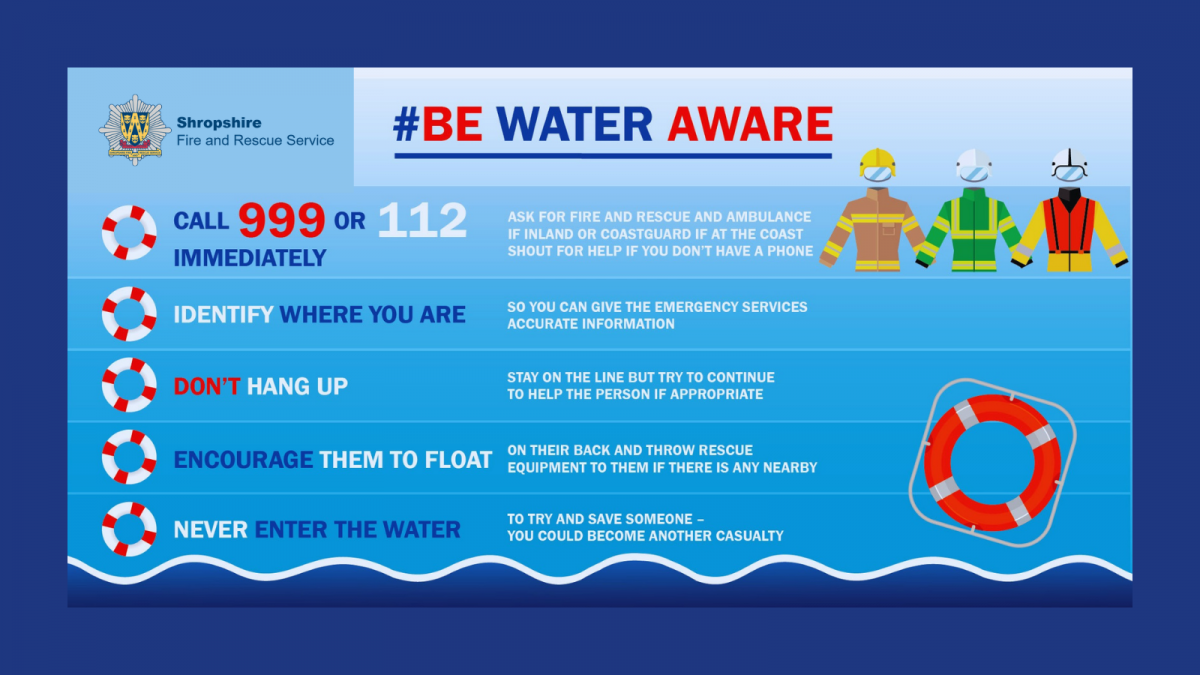
Shropshire is home to numerous rivers, lakes and quarries - all of which can seem very tempting to enter during hot weather or to cool off. As part of our prevention work, we strive to educate residents and visitors alike to the dangers of water and how to stay safe. This page contains all you need to know about water safety, as well as details of further information and online resources.
The dangers of water include:
- It is very cold
- There may be hidden currents
- It can be difficult to get out (steep slimy banks)
- It can be deep
- There may be hidden rubbish, e.g. shopping trolleys, broken glass
- There are no lifeguards
- It is difficult to estimate depth
- It may be polluted and may make you ill
Winter Water Safety
The Royal Life Saving Society of the UK have produced some excellent guidance about staying safe near water during the Winter months, when water can be even more dangerous
Winter water safety guidance and activity booklet

Advice for staying safe around water
- Keep away from the water's edge and closely supervise young children at all times.
- Never swim in open water when there are no life-guards present.
- Don't jump or dive into open water; submerged objects such as rocks may not be visible and can cause serious injuries.
- Be aware that there may be strong currents, even where the water surface appears calm.
- Weirs, locks, pipes and sluices are especially dangerous.
- Take note of warning signs, safety information or flags near the water's edge.
- Get out of the water as soon as you start to feel cold.
- Water can be very cold even in summer, causing cramp and breathing difficulties – these can affect even the strongest swimmer.
- Wear the recommended safety equipment for your activity, e.g life jackets/helmets.
- Always wear a life-jacket or other buoyancy aid for water-side activities such as angling or boating
- Alcohol may impair your ability and judgment; never go swimming under the influence of alcohol
Quarry safety
Quarries are dangerous places, even for the most competent of swimmers. The water can be very deep and cold, putting you at risk of hypothermia and cold shock, which can prevent your muscles from functioning properly. Loose, slippery sides can make it difficult to climb out, while unseen machinery and obstacles beneath the water can cause serious life-changing injuries or even death.
You can make a difference by:
- Ensuring that you and your family can swim, be water confident, and have water safety skills
- Making smart choices, such as swimming at lifeguarded beaches and pools, using appropriate safety equipment and not drinking alcohol before going in the water.
- Becoming aware of, and knowing how to avoid key water-safety hazards; such as rips, cold-water, moving water whilst outside.
- Dealing with hazards for children and vulnerable people in and around the home such as ponds, bath, swimming pools
- Taking opportunities for children and teenagers to develop 'risk-competence' by learning about safety by experiencing risk
- Knowing what to do in an emergency
Water Safety Videos
More of our videos can be located on our YouTube channel
Further resources and information
Online learning resources from Home and Dry
More about water safety from RoSPA
Resources for children from the Canal River Trust
Safety information and resources from the Royal Life Saving Society (RLSS)
Take the West Mercia Search and Rescue water safety online course here




